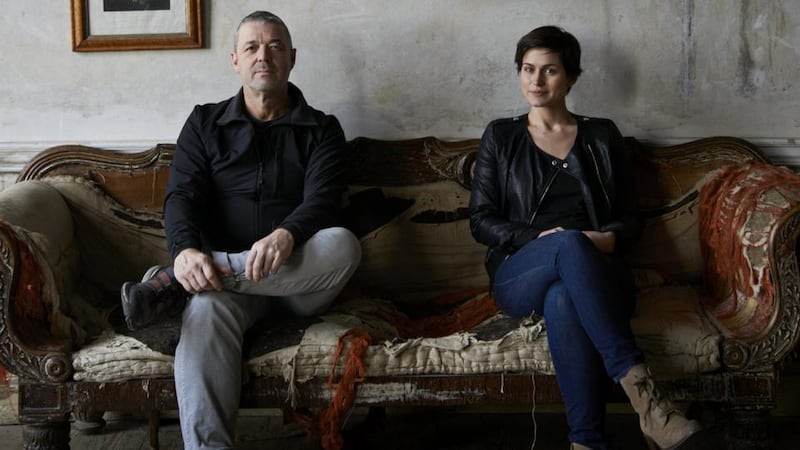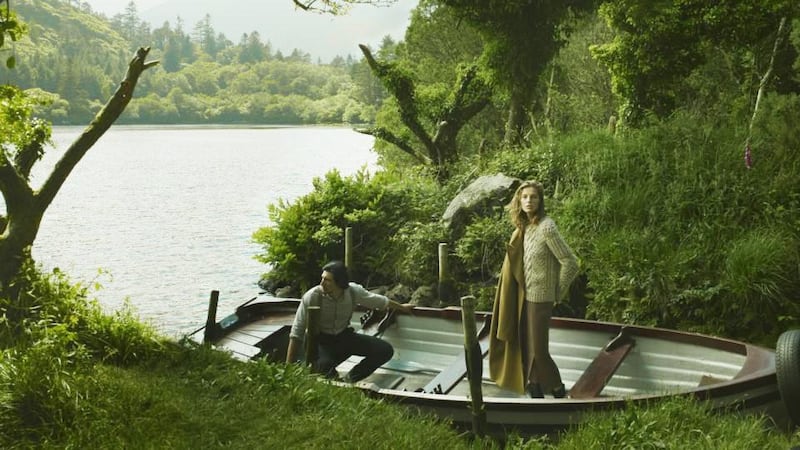When photographer Annie Leibovitz did the celebrated 16-page fashion shoot Wild Irish Rose in Ireland for the September issue of US Vogue last year, she attributed 80 per cent of its success to Nigel Swann.
A fine-art photographer and former model agent from Portadown, Swann and his production company Swann Locations have been luring high-profile photographers and influential international publications to this country for nearly 20 years, sourcing “inspirational” locations for the fashion, film and advertising industries.
Having sent 600 images of Ireland to Leibovitz in New York, he found the locations in Kerry for her, sorted out transport, catering, props (including 20 donkeys and the black sheep on today's cover) and accommodation for a 22-strong crew. He also drew her attention to Marie Heaney's Over Nine Waves: A Book of Irish Legends. Thus the love story of Diarmuid and Gráinne propelled this romantic shoot.


Widely respected in the international fashion industry, but little known outside it, Swann has been a de facto ambassador abroad for this country and its landscape, promoting diverse locations indoors and outdoors, all over the island.
He has some 70,000 images on file (including locations in Provence and Budapest), 10,000 of which are on his website.
Fáilte Ireland recently highlighted Ireland's landscape as the enduring cornerstone of its international tourism marketing campaigns and the exposure in US Vogue, with its 11 million readership, "helps to position Ireland as a highly desirable place to visit," says Alison Metcalfe, head of Tourism Ireland North America.
"The image of Ireland abroad is still either The Quiet Man or The Commitments: it's the west's rugged coastline or urban Dublin," says Swann when we meet in Dublin. "Every client sees it as an ancient land, and the Celtic twilight, but the dominant and lasting impression is the friendliness of the people.
“Every nationality that comes here, particularly Americans, are in awe of it. Italians love the space. The Japanese are spellbound by the light and the fact that you can get four seasons in one day. The light has to do with the rain – without it you don’t get that light. I have never had a job cancelled because of the weather,” he says.
His clients include French and Italian Vogue, Vanity Fair, Bergdorf Goodman, Nordstrom, Anthropologie in the US, H&M, Mr Porter, Pen magazine in Japan – to name a few.
After completing a degree in fine art sculpture in Dublin’s National College of Art & Design (where milliner Philip Treacy was a contemporary), he moved to London in the 1980s with his wife, the artist and printmaker Claire Carpenter, when she got a scholarship to the Chelsea College of Art. His career began at international model agency Models 1, where he worked for 11 years as an agent, getting to know “every photographer on the planet”.
Founded by José Fonseca and April Ducksbury, it launched the careers of supermodels such as Cecilia Chancellor, Yasmin Le Bon and Jerry Hall. Swann cut his teeth doing the casting negotiations for Robert Palmer's Addicted to Love video, directed by Terence Donovan.
“I was known for not exploiting models . . . Models today are savvier about how the industry works and those like Rosie Tapner use social networks to drive their brands. It’s a myth that they are stupid – they are bright, private little companies.”
He is proud of the fact that the Sudan-born supermodel Alek Wek credits him in her autobiography for taking her under his wing and looking after her at the start of her career.
During that time he met Dublin-based photographer Perry Ogden, working with him on a shoot for W magazine with Cecilia Chancellor in Galway. This spread led to Ralph Lauren giving his campaign to Ogden and marked the beginning for Swann of a personal and professional friendship with Ogden. "I judge every photographer now by his standards," he says.
Life changed for Swann when he fell while dancing and broke his knee-cap. The effect of having to stop work to recover led him to reflect on becoming a freelance producer. He moved back to Dublin, set up his photographic production company in 1996 and "faxed everybody I knew and within three weeks had secured the Emporio Armani catalogue with Perry, Australian Harper's Bazaar and Australian Elle. That was the start and it just got bigger," he says.
Now he commands a crew of 15 that can expand or contract exponentially with freelancers when necessary.
Along with Ireland, he organises shoots in Budapest, a move prompted during “the greedy Celtic Tiger years when prices in Ireland went berserk, though now hotels in Ireland are seriously up for business again,” he says.
One of his biggest clients is Anthropologie, the US clothing, home and accessories giant, with 180 stores in Europe alone.
“I have worked with them for 14 years and they know I ‘get’ the product. I have shot in Sri Lanka and have organised locations in Ireland, Scotland, Slovakia, Budapest, Slovenia, Italy, Portugal and Rome. They love the distressed look – but at the end of the day, it is about the clothes.”
He recalls, over the years, shoots in the Cooley Peninsula for Dries Van Noten, Nieman Marcus and Bergdorf Goodman, in Donegal for the Toast and Boden catalogues, at Usna hill outside Mullingar for Pen magazine, in Bantry for the wedding site BHLDN, a sister brand of Anthropologie, and in the Burren for ottod'Ame in Florence.
“Once there’s tweed, it’s either Ireland or Scotland,” he smiles.
Location is crucial but so are logistics and hotels must be nearby, and able to cater for big crews, sometimes at short notice. “Production-friendly” Irish hotels he name checks include Aghadoe Heights in Killarney, Zetland Country House in Connemara, Sneem Hotel in Kerry, the Radisson Blu in Letterkenny, Liss Ard in Skibbereen and the Dylan in Dublin.
Recently, he has taken on a co-producer, Maria Walsh, an Irish American who was born in Boston but returned to Shrule, Co Mayo, with her Irish parents when she was seven.
After graduating in journalism from Griffith College, Walsh moved to New York and worked as a producer with Anthropologie, where she met and worked with Swann.
Now, he would like "to drill even deeper and get better stuff". He would like to attract Chinese Vogue, "and its editor who is the most powerful woman in fashion, with a 30-million readership and attract more Chinese to Ireland". His wife's family were missionaries in China.
In person, he is mischievous, open and talkative, but with die-hard drive. Surprisingly, for one with so many professional contacts and influence internationally, he has no Irish clients.
He is based in a “triangle” of France, Budapest and the Cooley mountains. His busiest period is from February to November when clients shoot their autumn/winter campaigns.
“They want the natural beauty of Ireland at some point and the long daylight hours at that time mean they can get a lot of work done – seven to 10 shots a day. The accessibility and diversity of our countryside and coast is incredibly helpful from a production point of view – and their experience here reinforces their [positive] conception of Ireland and its people.”
His next project, still under wraps, could be the biggest coup of his career, but for the moment, his lips are sealed.
See swannlocations.com







